Development of Community-Level Capacity of Resilience to Natural Hazards for Environmental- and Social-Justice-Challenged Communities: 1. Approach, Concepts, and Assessment of Existing Information
Abstract
1. Introduction
2. Methods
3. Results
3.1. The Selected Parishes
3.2. Deconstruction of Resilience Indicators
4. Discussion
Next Steps
- (1)
- Do you believe St. Helena Parish and its communities would benefit from resilience capacity building related to natural hazard events?
- (2)
- What are the parish’s greatest strengths and most significant shortcomings regarding these natural hazard events?
- (3)
- Can the communications infrastructure for the parish be improved? If so, how?
- (4)
- Do you believe there are a large number of vacant structures in the parish? What types? Would they contribute to poor parish-level resilience?
- (5)
- Would you consider the parish at high risk for loss of human life and high levels of property loss due to natural hazard events?
- (6)
- Could labor–trade services and social services for the parish be improved? How?
- (7)
- Do you believe the parish has serious levels of health issues like asthma and diabetes?
- (8)
- Do you believe the parish has an unacceptable proportion of families experiencing deep poverty? Does the parish display economic, environmental, climatic, or social inequities?
5. Conclusions
Author Contributions
Funding
Institutional Review Board Statement
Informed Consent Statement
Data Availability Statement
Conflicts of Interest
References
- Holling, C.S. Resilience and stability of ecological systems. Annu. Rev. Ecol. Syst. 1973, 4, 1–23. [Google Scholar] [CrossRef]
- Davidson, J.L.; Jacobsson, C.; Lyth, A.; Dedekorkut-Howes, A.; Baldwin, C.L.; Ellison, J.C.; Holbrook, N.J.; Howes, M.J.; Serrao-Neumann, S.; Singh-Peterson, L.; et al. Interrogating resilience toward a typology to improve its operationalization. Ecol. Soc. 2016, 21, 27. [Google Scholar] [CrossRef]
- Therrien, M.; Usher, S.; Matyas, D. Enabling strategies and impeding factors to urban resilience implementation: A scoping review. J. Contingencies Crisis Manag. 2020, 28, 83–102. [Google Scholar] [CrossRef]
- Bruneau, M.; Chang, S.E.; Eguchi, R.T.; Lee, G.; O’Rourke, T.D.; Reinhorn, A.M.; Shinozuka, M.; Tierney, K.; Wallace, W.A.; von Winterfeldt, D. A framework to quantitatively assess and enhance the seismic resilience of communities. Earthq. Spectra 2003, 19, 733–752. [Google Scholar] [CrossRef]
- Ouyang, M.; Duenas-Osorio, L.; Min, X. A three-stage resilience analysis framework for urban infrastructure systems. Struct. Saf. 2012, 36–37, 23–31. [Google Scholar] [CrossRef]
- Cimellaro, G.P.; Reinhorn, A.M.; Bruneau, M. Framework for analytical quantification of disaster resilience. Eng. Struct. 2010, 32, 3639–3649. [Google Scholar] [CrossRef]
- Zobel, C.W.; Khansa, L. Characterizing multi-event disaster resilience. Comput. Oper. Res. 2014, 42, 83–94. [Google Scholar] [CrossRef]
- Smith, D.; Veitch, B.; Khan, F.; Taylor, R. Integration of resilience and FRAM for safety management. ASCE-ASME J. Risk Uncertain. Eng. Syst. Part A Civ. Eng. 2020, 6, 04020008. [Google Scholar] [CrossRef]
- Atallah, D.G.; Bacigalupe, G.; Repetto, P. Centering at the margins: Critical community resilience praxis. J. Humanist. Psychol. 2021, 61, 875–905. [Google Scholar] [CrossRef]
- Paton, D.; Johnston, D. Disasters and communities: Vulnerability, resilience and preparedness. Disaster Prev. Manag. Int. J. 2001, 10, 270–277. [Google Scholar] [CrossRef]
- Wilkin, J.; Biggs, E.; Tatem, A. Measurement of social networks for innovation within community disaster resilience. Sustainability 2019, 11, 1943. [Google Scholar] [CrossRef]
- Folke, C. Resilience: The emergence of a perspective for social-ecological systems analyses. Glob. Environ. Chang. 2006, 16, 253–267. [Google Scholar] [CrossRef]
- Nagenborg, M. Urban resilience and distributive justice. Sustain. Resilient Infrastruct. 2019, 4, 103–111. [Google Scholar] [CrossRef]
- Gallopin, G.C. Linkages between vulnerability, resilience, and adaptive change. Glob. Environ. Chang. 2006, 16, 293–303. [Google Scholar] [CrossRef]
- The Rockefeller Foundation and Arup. City Resilience Framework 2015. Ove Arup and Partners Interactions. 2014. Available online: https://www.rockefellerfoundation.org/report/city-resilience-framework/ (accessed on 17 January 2024).
- Bahadur, A.; Tanner, T. Transformational resilience thinking: Putting people, power and politics at the heart of urban climate resilience. Environ. Urban. 2014, 26, 200–214. [Google Scholar] [CrossRef]
- Olsson, P.; Galaz, V.; Boonstra, W.J. Sustainability transformations: A resilience perspective. Ecol. Soc. 2014, 19, 1. [Google Scholar] [CrossRef]
- Yumagulova, L.; Vertinsky, I. Moving beyond engineering supremacy: Knowledge systems for urban resilience in Canada’s Metro Vancouver region. Environ. Sci. Policy 2019, 100, 66–73. [Google Scholar] [CrossRef]
- Cutter, S.L.; Barnes, L.; Berry, M.; Burton, C.; Evans, E.; Tate, E.; Webb, J. A place-based model for understanding community resilience to natural disasters. Glob. Environ. Chang. 2008, 18, 598–606. [Google Scholar] [CrossRef]
- Links, J.M.; Schwartz, B.S.; Lin, S.; Kanarek, N.; Mitrani-Reiser, J.; Sell, T.K.; Watson, C.R.; Ward, D.; Slemp, C.; Burhans RGill, K.; et al. COPEWELL: A conceptual framework and system dynamics model for predicting community functioning and resilience after disasters. Disaster Med. Public Health Prep. 2018, 12, 127–137. [Google Scholar] [CrossRef]
- Mayer, B. A review of the literature on community resilience and disaster recovery. Curr. Environ. Health Rep. 2019, 6, 167–173. [Google Scholar] [CrossRef]
- Summers, J.K.; Harwell, L.C.; Buck, K.D.; Smith, L.M.; Vivian, D.N.; Harvey, J.E.; McLaughlin, M.D.; Hafner, S.F.; McMillion, C.A. Development of a Cumulative Resilience Screening Index (CRSI) for Natural Hazards. Sustainable and Healthy Communities Research Program Technical Report; EPA600/R-20/274; Office of Research & Development: Washington, DC, USA, 2020. [Google Scholar]
- Summers, J.K.; Smith, L.M.; Harwell, L.C.; Buck, K.D. Conceptualizing holistic community resilience to climate events: Foundation for a climate resilience screening index. GeoHealth 2017, 1, 151–164. [Google Scholar] [CrossRef] [PubMed]
- Smith, L.M.; Smith, H.M.; Case, J.L.; Harwell, L.C.; Summers, J.K. Indicators and Methods for Constructing a U.S. Human Well-Being Index (HWBI) for Ecosystem Services Research; EPA/600/R-12/023; Office of Research & Development: Washington, DC, USA, 2012. [Google Scholar]
- Summers, J.K.; Smith, L.M.; Harwell, L.C.; Case, J.L.; Wade, C.M.; Straub, K.R.; Smith, H.M. An Index of Human Well-Being for the U.S.: A TRIO Approach. Sustainability 2014, 6, 3915–3935. [Google Scholar] [CrossRef]
- Summers, K.; Salazar, V.; Olszyk, D.; Harwell, L.; Brookes, A. The Development of DISC (Decision Integration for Strong Communities): An Agile Software Application of Sustainability Indicators for Small and Rural Communities; Ridzi, F., Stevens, C., Davern, M., Eds.; Community Quality-of-Life Indicators: Best Cases VIII; Springer-Link Publishers: Berlin/Heidelberg, Germany, 2020; pp. 89–113. [Google Scholar]
- USEPA (United States Environmental Protection Agency). EJScreen: Environmental Justice Screening and Mapping Tool. 2023. Available online: https://www.epa.gov/ejscreen (accessed on 11 December 2023).
- CEQ (Council on Environmental Quality). Climate and Economic Justice Screening Tool. 2023. Available online: https://screeningtool.geoplatform.gov/en/#3/33.47/-97.5 (accessed on 11 December 2023).
- Fos, P.J.; Honore, P.A.; Honore, R.L. Air pollution and COVID-19: A* comparison of Europe and the United States. Eur. J. Environ. Public Health 2021, 5, em0074. [Google Scholar] [CrossRef] [PubMed]
- Terrell, K.A.; James, W. Racial disparities in air pollution burden and COVID-19 deaths in Louisiana, USA, in the context of long-term changes in fine particulate pollution. Environ. Justice 2022, 15, 286–297. [Google Scholar] [CrossRef]
- Grace, D.; Sen, B. Community resilience and the role of the public library. Libr. Trends 2013, 61, 513–541. [Google Scholar] [CrossRef]
- Veil, S.R.; Bishop, B.W. Opportunities and challenges for public libraries to enhance community resilience. Risk Anal. 2014, 34, 721–734. [Google Scholar] [CrossRef] [PubMed]
- Aydin, C.; Tarhan, C.; Ozgur, A.S.; Tecim, V. Improving disaster resilience using mobile based disaster management system. Procedia Technol. 2016, 22, 382–390. [Google Scholar] [CrossRef][Green Version]
- Anderson, M.J.; Kiddle DA, F.; Logan, T.M. The underestimated role of the transportation network: Improving disaster & community resilience. Transp. Res. Part D Transp. Environ. 2022, 106, 103218. [Google Scholar]
- McAllister, T.; McAllister, T. Developing Guidelines and Standards for Disaster Resilience of the Built Environment: A Research Needs Assessment; US Department of Commerce, National Institute of Standards and Technology: Gaithersburg, MD, USA, 2013; pp. 1–142. Available online: https://nvlpubs.nist.gov/nistpubs/TechnicalNotes/NIST.TN.1795.pdf (accessed on 11 December 2023).
- Ribeiro, D.; Mackres, E.; Baatz, B.; Cluett, R.; Jarrett, M.; Kelly, M.; Vaidyanathan, S. Enhancing Community Resilience through Energy Efficiency. American Council for an Energy-Efficient Economy. 2015. Available online: https://c2e2.unepccc.org/wp-content/uploads/sites/2/2016/03/u1508.pdf (accessed on 11 December 2023).
- Aldrich, D.P. The importance of social capital in building community resilience. Rethink. Resil. Adapt. Transform. A Time Chang. 2017, 23, 357–364. Available online: https://www.researchgate.net/profile/Daniel-Aldrich/publication/316117238_The_Importance_of_Social_Capital_in_Building_Community_Resilience/links/5aa925d3458515178818a3f9/The-Importance-of-Social-Capital-in-Building-Community-Resilience.pdf (accessed on 11 December 2023).
- Kim, H.; Marcouiller, D.W.; Woosnam, K.M. Rescaling social dynamics in climate change: The implications of cumulative exposure, climate justice, and community resilience. Geoforum 2018, 96, 129–140. [Google Scholar] [CrossRef]
- Ma, Z.; Guo, S.; Deng, X.; Xu, D. Community resilience and resident’s disaster preparedness: Evidence from China’s earthquake-stricken areas. Nat. Hazards 2021, 108, 567–591. [Google Scholar] [CrossRef]
- Poortinga, W. Community resilience and health: The role of bonding, bridging, and linking aspects of social capital. Health Place 2012, 18, 286–295. [Google Scholar] [CrossRef] [PubMed]
- Patel, R.B.; Gleason, K.M. The association between social cohesion and community resilience in two urban slums of Port au Prince, Haiti. Int. J. Disaster Risk Reduct. 2018, 27, 161–167. [Google Scholar] [CrossRef]
- O’Grady, N.; Shaw, D.; Parzniewski, S. People in a pandemic: Rethinking the role of ‘Community’ in community resilience practices. Geoforum 2022, 132, 32–41. [Google Scholar] [CrossRef] [PubMed]
- Shava, S.; Zazu, C.; Tidball, K.; O’Donoghue, R. Local knowledge as a source of community resilience: IKS community development and resilience. Indilinga Afr. J. Indig. Knowl. Syst. 2009, 8, 218–229. [Google Scholar]
- Zhang, H.; Nakagawa, H. Validation of indigenous knowledge for disaster resilience against river flooding and bank erosion. In Science and Technology in Disaster Risk Reduction in Asia; Academic Press: Cambridge, MA, USA, 2018; pp. 57–76. [Google Scholar]
- Cajete, G.A. Indigenous science, climate change, and indigenous community building: A framework of foundational perspectives for indigenous community resilience and revitalization. Sustainability 2020, 12, 9569. [Google Scholar] [CrossRef]
- Malapane, O.L.; Musakawa, W.; Chanza, N.; Radinger-Peer, V. Bibliometric analysis and systematic review of indigenous knowledge from a comparative African perspective 1990–2020. Land 2022, 11, 1167. [Google Scholar] [CrossRef]
- Berkes, F.; Folke, C.; Gadgil, M. Traditional ecological knowledge, biodiversity, resilience and sustainability. In Biodiversity Conservation: Problems and Policies; Perrings, C.A., Maler, K.G., Folke, C., Holling, C.S., Jansson, B., Eds.; Springer: Dordrecht, The Netherlands, 1994; pp. 269–287. [Google Scholar]
- Berkes, F.; Colding, J.; Folke, C. Rediscovery of traditional ecological knowledge as adaptive management. Ecol. Appl. 2000, 10, 1251–1262. [Google Scholar] [CrossRef]
- Coles, E.; Buckle, P. Developing community resilience as a foundation for effective disaster recovery. Aust. J. Emerg. Manag. 2004, 19, 6–15. [Google Scholar]
- Bowen, F.; Newenham-Kahindi, A.; Herremans, I. When suits meet roots: The antecedents and consequences of community engagement strategy. J. Bus. Ethics 2010, 95, 297–318. [Google Scholar] [CrossRef]
- Morton, M.J.; Lurie, N. Community resilience and public health practice. Am. J. Public Health 2013, 103, 1158–1160. [Google Scholar] [CrossRef]
- Pfefferbaum, B.; Pfefferbaum, R.L.; Van Horn, R.L. Community resilience interventions: Participatory, assessment-based, action-oriented processes. Am. Behav. Sci. 2015, 59, 238–253. [Google Scholar] [CrossRef]
- Campanella, T.J. Urban resilience and the recovery of New Orleans. J. Am. Plan. Assoc. 2006, 72, 141–146. [Google Scholar] [CrossRef]
- Borie, M.; Pelling, M.; Ziervogel, G.; Hyams, K. Mapping narratives of urban resilience in the global south. Glob. Environ. Chang. 2019, 54, 203–213. [Google Scholar] [CrossRef]
- Mehmood, A. Of resilient places: Planning for urban resilience. Eur. Plan. Stud. 2016, 24, 407–419. [Google Scholar] [CrossRef]
- Harris, L.M.; Chu, E.K.; Ziervogel, G. Negotiated resilience. Resilience 2017, 6, 196–214. [Google Scholar] [CrossRef]
- Blackman, D.; Nakanishi, H.; Benson, A.M. Disaster resilience as a complex problem: Why linearity is not applicable for long-term recovery. Technol. Forecast. Soc. Chang. 2017, 121, 89–98. [Google Scholar] [CrossRef]
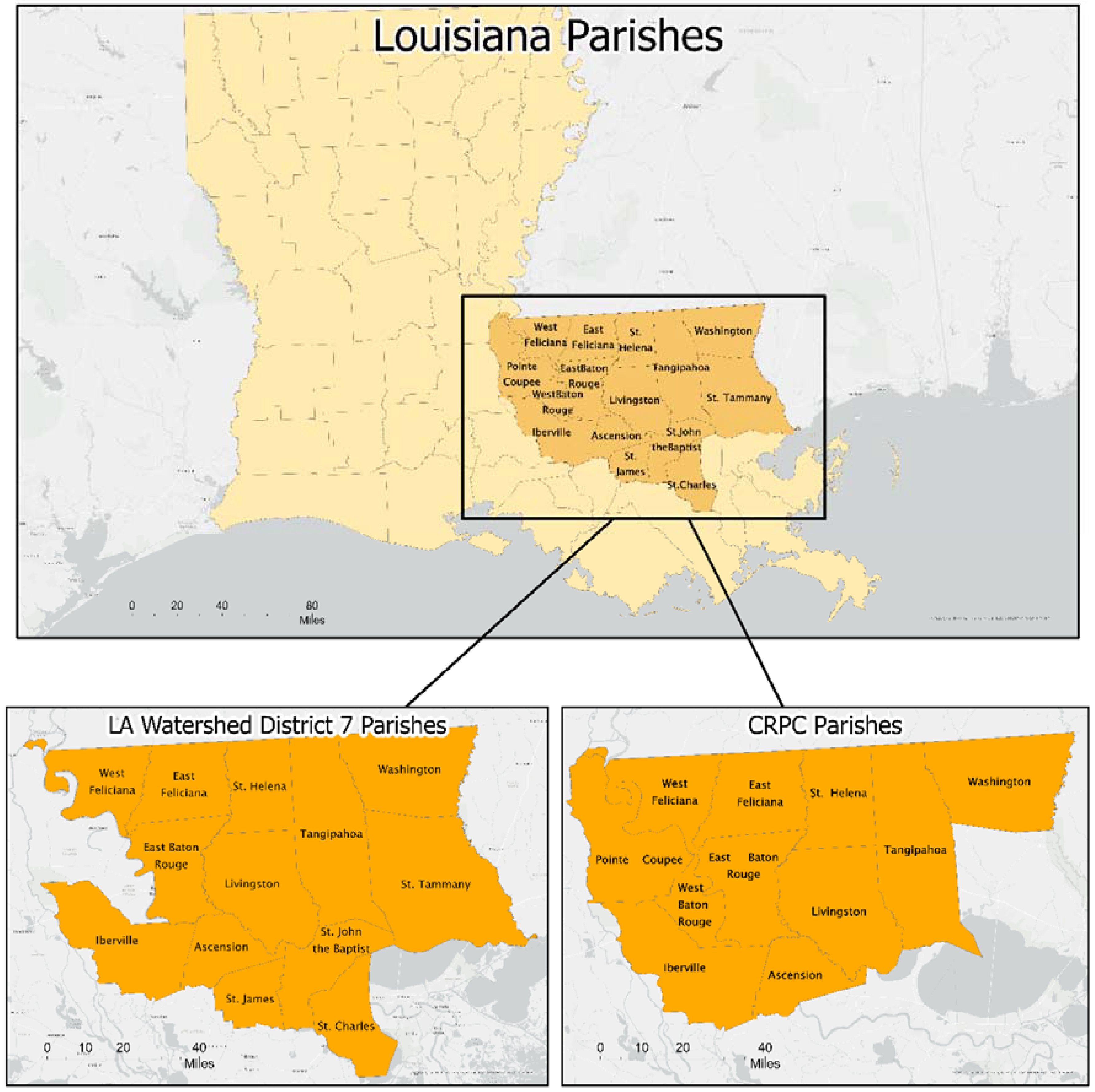
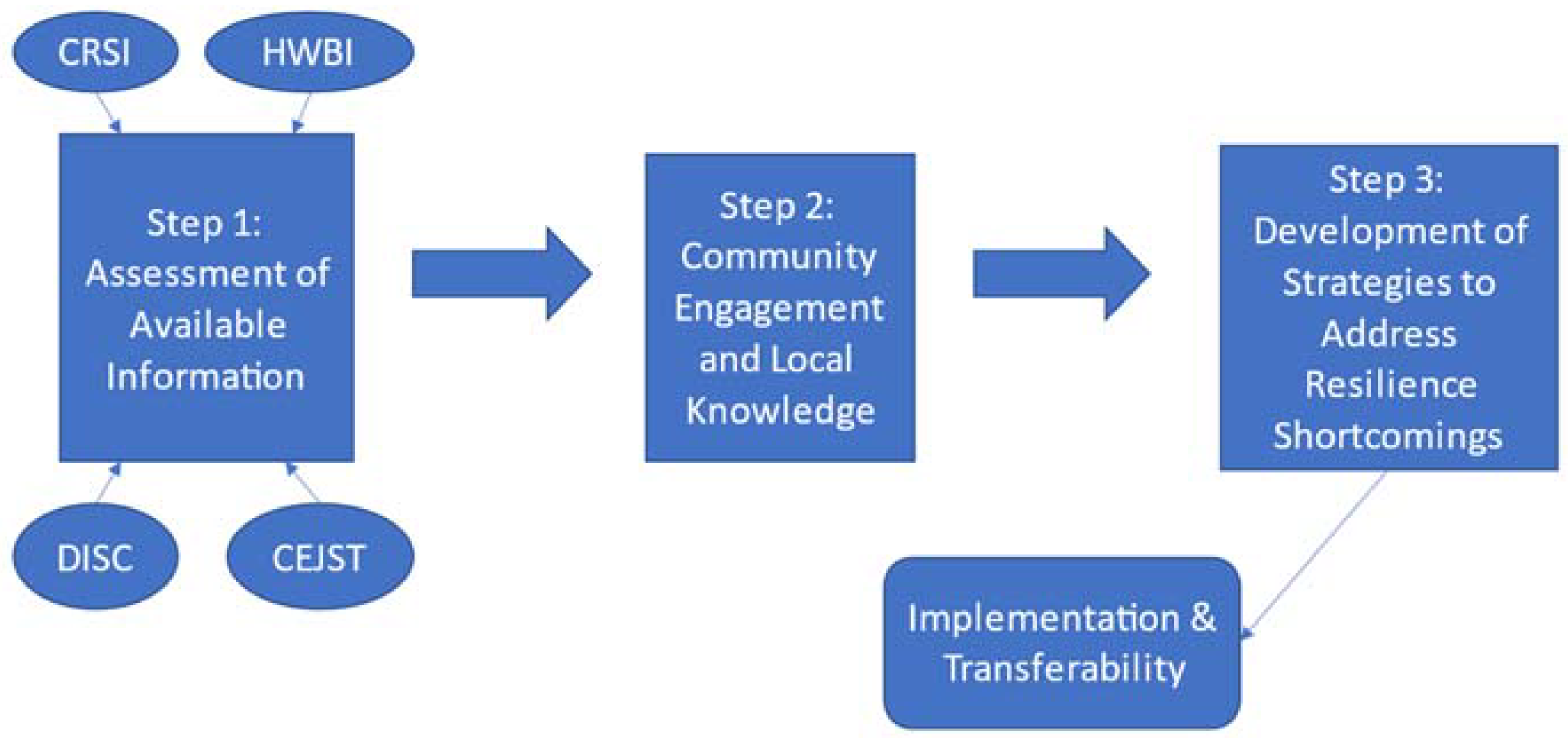
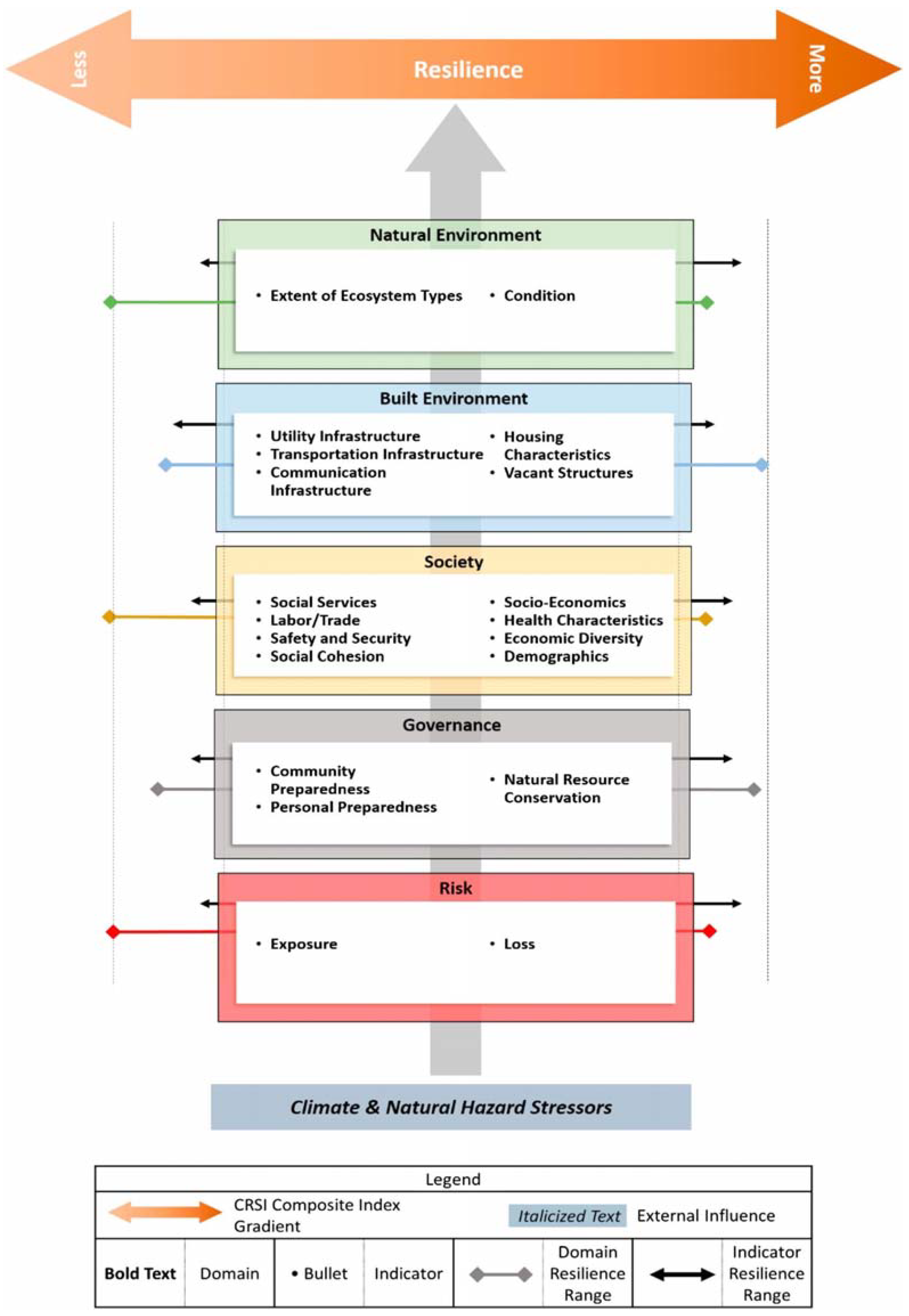
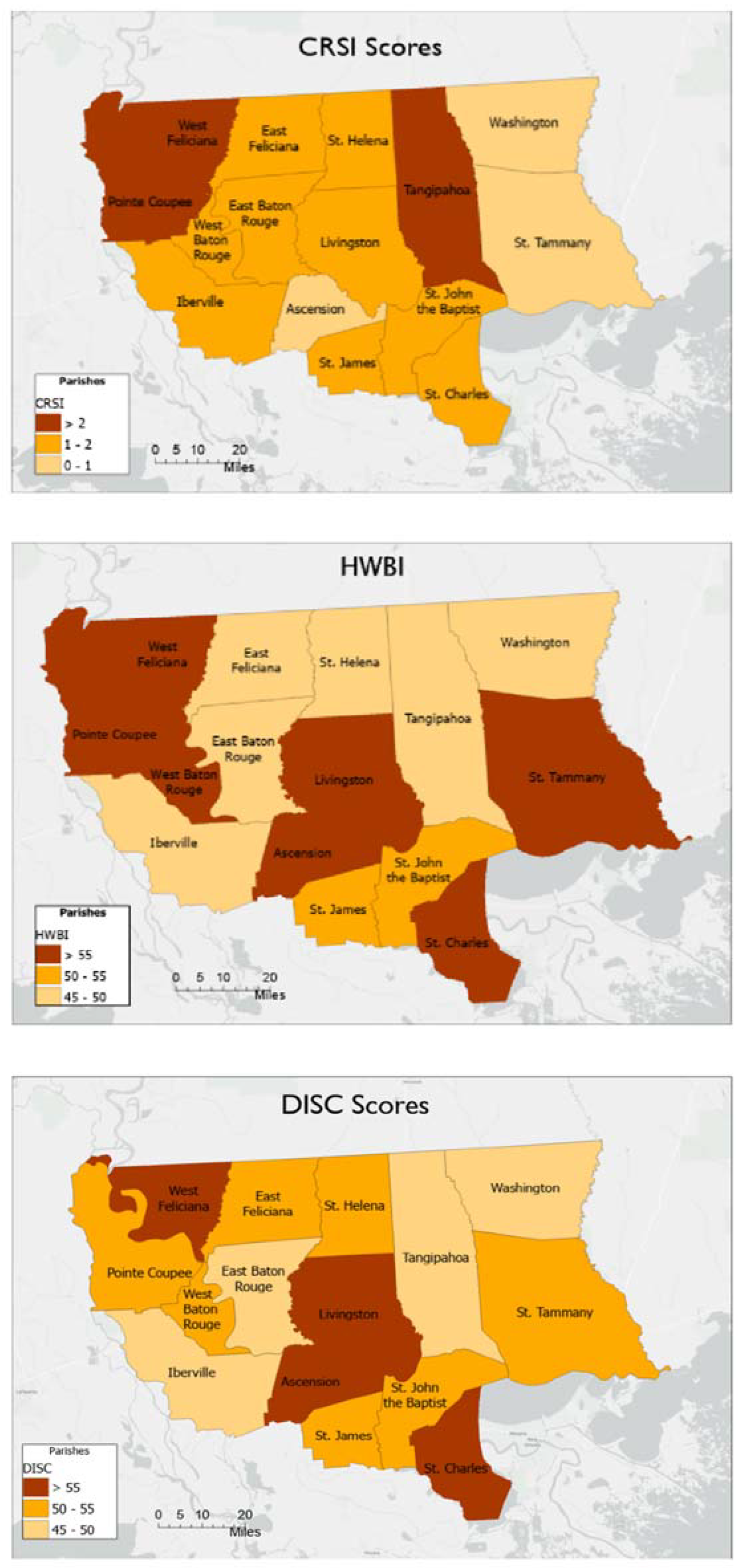
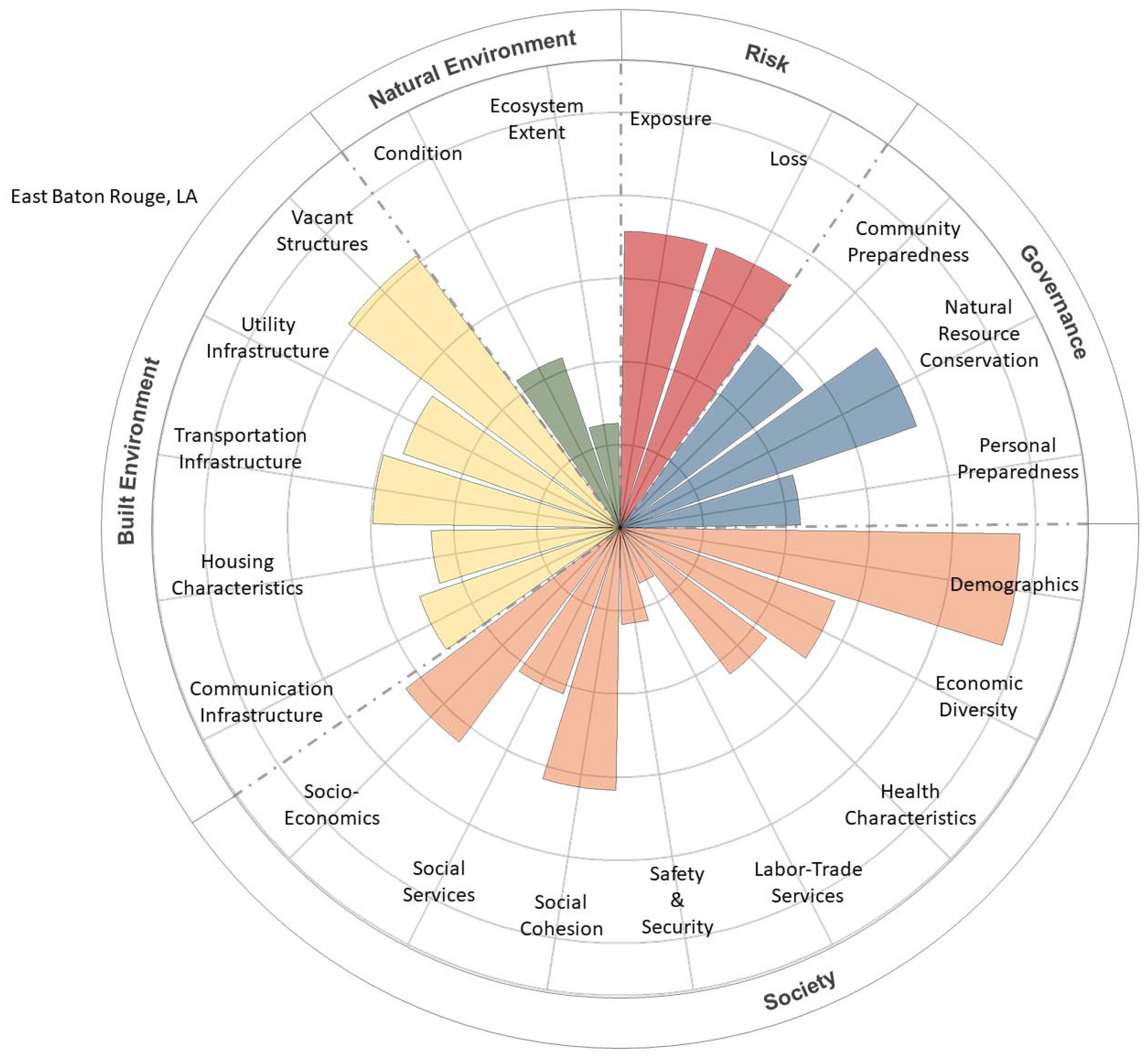
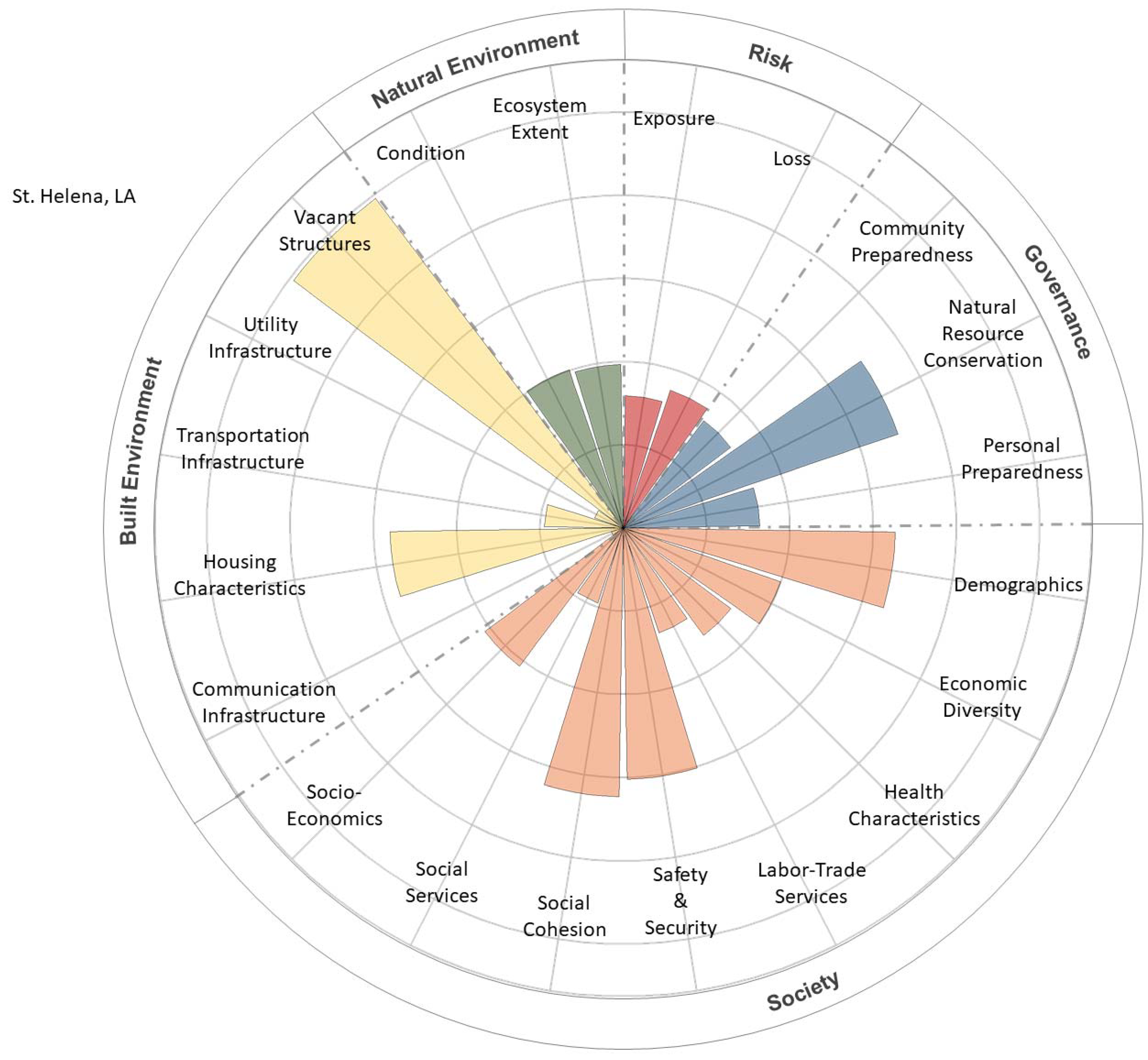
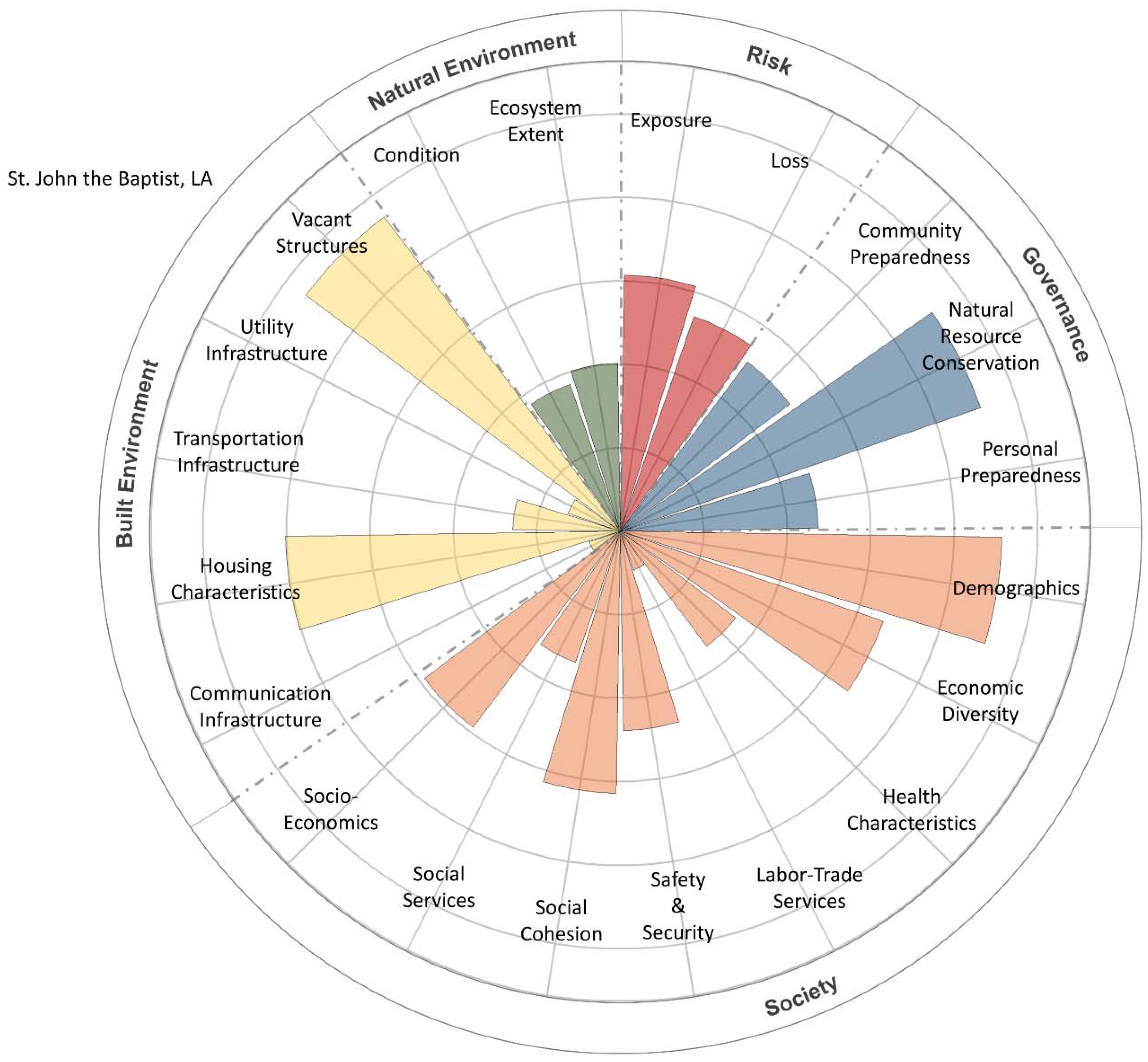
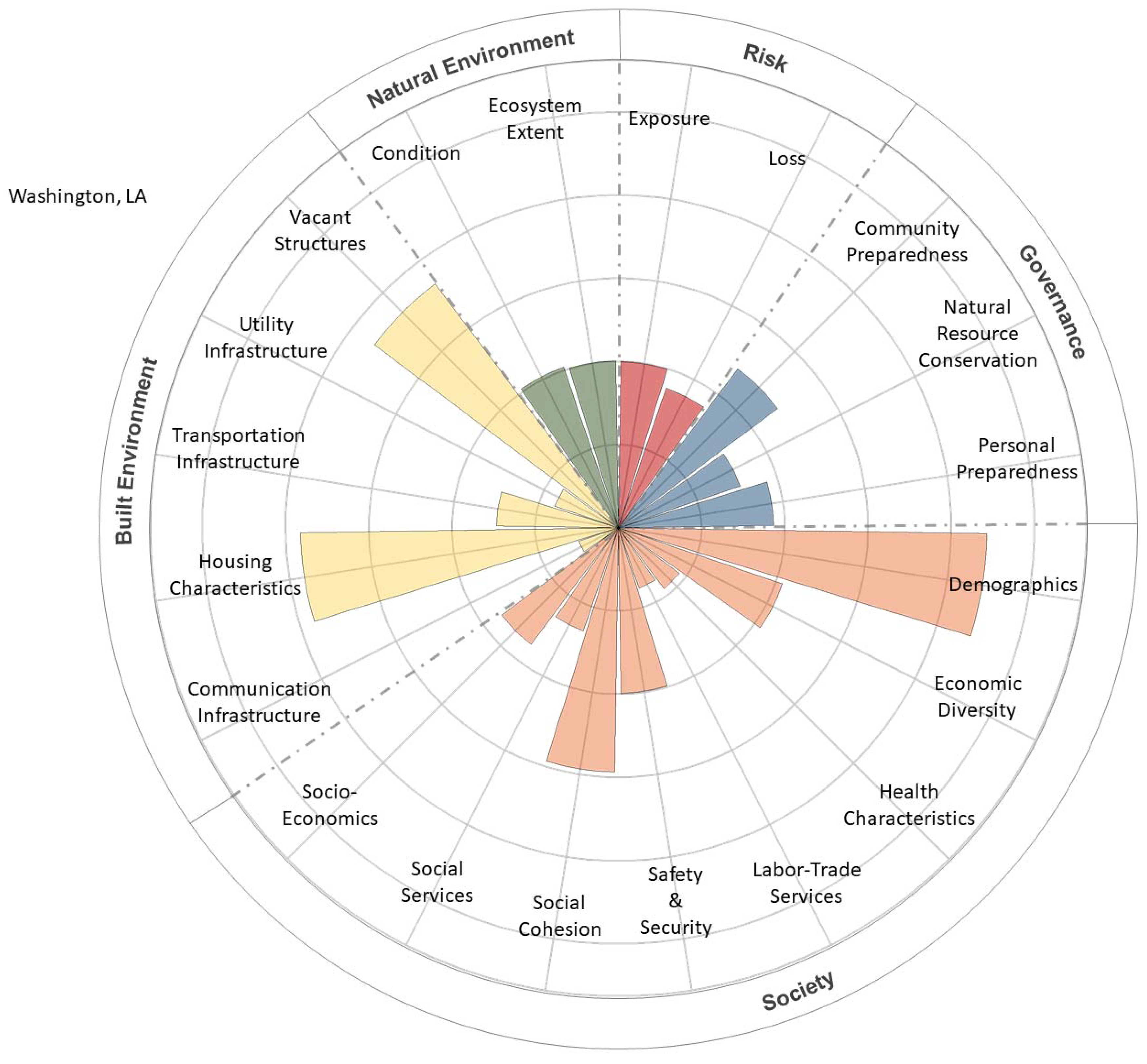
| Region | Parish | CRSI | HWBI | DISC | EJScreen | CEJST |
|---|---|---|---|---|---|---|
| Mean Score | % Census Tracts Listed as True | |||||
| CRPC and LW #7 | Ascension | 0.889 | 54.2 | 55.1 | 14.3 | 21.43 |
| East Feliciana | 1.270 | 47.0 | 50.1 | 61.2 | 60.00 | |
| East Baton Rouge | 1.325 | 47.8 | 50.0 | 73.9 | 46.73 | |
| Iberville | 1.600 | 46.8 | 49.7 | 73.3 | 71.43 | |
| Livingston | 1.392 | 54.0 | 55.5 | 13.3 | 11.76 | |
| St. Helena | 1.305 | 47.9 | 50.6 | 60.7 | 50.00 * | |
| Tangipahoa | 2.005 | 48.2 | 49.6 | 61.5 | 65.00 | |
| Washington | 0.882 | 48.3 | 49.2 | 66.9 | 90.91 | |
| West Feliciana | 2.169 | 52.8 | 55.3 | 56.1 | 33.33 | |
| LW #7 only | St. Charles | 1.642 | 55.0 | 55.2 | 28.0 | 23.08 |
| St. James | 1.549 | 50.7 | 52.4 | 59.8 | 57.14 | |
| St. John the Baptist | 1.591 | 51.6 | 54.3 | 77.3 | 63.64 | |
| St. Tammany | 0.968 | 53.1 | 53.5 | 15.4 | 18.60 | |
| CRPC Only | Pointe Coupee | 2.348 | 53.0 | 54.5 | 57.7 | 50.00 |
| West Baton Rouge | 1.721 | 53.1 | 54.2 | 52.0 | 40.00 | |
| Louisiana | All Parishes Combined | 2.501 | 49.0 | 52.0 | ||
| United States | All Counties Combined | 3.060 | 54.1 | 54.7 | ||
| Mean for CRPC Parishes | 1.537 | 50.3 | 52.2 | 53.7 | 49.15 |
| Indicator | Metric | East Baton Rouge | St. Helena | St. John The Baptist | Washington |
|---|---|---|---|---|---|
| Communications Infrastructure | Access to Internet | Bottom 1% | Bottom 1% | Bottom 1% | Bottom 1% |
| Number of Mobile Broadcast Towers | Bottom 11% | Bottom 1% | Bottom 1% | Bottom 1% | |
| Number of Paging Transmission Towers | Bottom 50% | Bottom 1% | Bottom 8% | Bottom 1% | |
| Number of Radio Broadcast Towers | Bottom 39% | Bottom 3% | Bottom 2% | Bottom 11% | |
| Number of TV Station Transmitters | Top 88% | Bottom 1% | Bottom 1% | Bottom 1% | |
| Transportation Infrastructure | Access to Highways | Bottom 5% | Bottom 7% | Bottom 5% | Bottom 1% |
| Utilities Infrastructure | Power Plant Facilities | Top 50% | Bottom 1% | Bottom 1% | Bottom 16% |
| Wastewater Treatment Facilities | Top 1% | Bottom 1% | Bottom 28% | Bottom 8% | |
| Drinking Water Facilities | Bottom 16% | Bottom 19% | Bottom 13% | Bottom 24% | |
| Vacant Structures | Business | Top 1% | Top 1% | Top 4% | Top 12% |
| Residential | Top 3% | Top 1% | Top 1% | Top 4% | |
| Other | Top 1% | Top 1% | Top 1% | Top 1% | |
| Housing Characteristics | Over 1.5 persons/room | Top 1% | Top 1% | Top 1% | Top 1% |
| Incomplete Plumbing | Top 1% | Top 1% | Top 1% | Top 2% | |
| Mobile Homes | Top 1% | Bottom 27% | Top 7% | Top 11% | |
| Community Preparedness | Re-investment of SBA * in mitigation | Bottom 1% | Bottom 1% | Bottom 1% | Bottom 1% |
| Personal Preparedness | Participation in NFIP ** | Bottom 7% | Bottom 20% | Bottom 17% | Botto 17% |
| Natural Resource Conservation | Protected Lands | Bottom 1% | Top 31% | Top 10% | Bottom 31% |
| Loss to Impervious Surface | Top 99% | Top 95% | Top 26% | Bottom 5% | |
| Protecting Biodiversity | Top 60% | Top 57% | Top 72% | Bottom 31% | |
| Indicator | Metric | East Baton Rouge | St. Helena | St. John The Baptist | Washington |
| Risk | Loss of Human Life And Property | Top 14% | Top 1% | Top 1% | Top 1% |
| Safety and Security | Ambulance Services | Bottom 1% | Bottom 1% | Bottom 19% | Bottom 33% |
| Labor–Trade Services | Concrete Construction | Bottom 7% | Bottom 1% | Bottom 18% | Bottom 7% |
| Framing Construction | Bottom 7% | Bottom 1% | Bottom 1% | Bottom 6% | |
| Water and Sewer Construction | Bottom 7% | Bottom 26% | Bottom 6% | Bottom 5% | |
| Masonry, Power Generation, Roofing | Bottom 10% | Bottom 1% | Bottom 6% | Bottom 15% | |
| Steel Fabrication | Bottom 17% | Top 4% | Bottom 1% | Bottom 41% | |
| Social Services | Surgical Services | Bottom 29% | Bottom 1% | Bottom 27% | Bottom 25% |
| Blood Availability | Bottom 7% | Bottom 1% | Bottom 1% | Bottom 1% | |
| Food Services for the Needy | Bottom 7% | Bottom 1% | Bottom 1% | Bottom 23% | |
| Number of Insurance Claims Establishments | Bottom 47% | Bottom 1% | Top 37% | Bottom 26% | |
| Mental Health Establishments | Bottom 36% | Bottom 1% | Bottom 12% | Bottom 1% | |
| Inpatient Nursing and Rehab Services | Bottom 16% | Bottom 1% | Bottom 6% | Bottom 17% | |
| Social Advocacy Groups | Bottom 15% | Bottom 1% | Bottom 1% | Bottom 17% | |
| Special Needs Transportation | Bottom 13% | Bottom 1% | Bottom 1% | Bottom 1% | |
| Number of Mental Health Professionals | Bottom 36% | Bottom 1% | Bottom 12% | Bottom 1% | |
| Basic School Facilities | Bottom 33% | Top 53% | Bottom 36% | Bottom 15% | |
| Demographics | Population > 25 yrs and Education < 9th Grade | Top 1% | Top 31% | Top 5% | Top 9% |
| Population < 14 yrs with Limited English | Top 2% | Top 33% | Top 8% | Top 4% | |
| Proportion of Population Without HS Diploma | Top 1% | Top 41% | Top 10% | Top 11% | |
| Proportion of Population < 5 yrs | Top 1% | Top 33% | Top 9% | Top 8% | |
| Indicator | Metric | East Baton Rouge | St. Helena | St. John The Baptist | Washington |
| Demographics | Population > 65 yrs and Living Alone | Top 25% | Top 60% | Top 59% | Top 37% |
| Health Characteristics | Incidence of Adult Asthma | Top 8% | Top 8% | Top 8% | Top 8% |
| Incidence of Child Asthma | Top 9% | Top 9% | Top 9% | Top 9% | |
| Incidence of Diabetes | Top 11% | Top 15% | Top 12% | Top 15% | |
| Special Needs with Limited Ability to Evacuate | Top 13% | Top 23% | Top 15% | Top 23% | |
| Socioeconomics | Population Below Poverty Level | Top 39% | Top 62% | Top 36% | Top 60% |
| Economic Diversity | Income Disparity (GINI Score) | Top 64% | Top 61% | Top 39% | Top 67% |
Disclaimer/Publisher’s Note: The statements, opinions and data contained in all publications are solely those of the individual author(s) and contributor(s) and not of MDPI and/or the editor(s). MDPI and/or the editor(s) disclaim responsibility for any injury to people or property resulting from any ideas, methods, instructions or products referred to in the content. |
© 2024 by the authors. Licensee MDPI, Basel, Switzerland. This article is an open access article distributed under the terms and conditions of the Creative Commons Attribution (CC BY) license (https://creativecommons.org/licenses/by/4.0/).
Share and Cite
Summers, J.K.; Sanderson, R.; Trahan, R.; Hendricks, K.; Ruffin, M.; Williams, A.; Lamper, A.; Lowery, M.; Harwell, L.C. Development of Community-Level Capacity of Resilience to Natural Hazards for Environmental- and Social-Justice-Challenged Communities: 1. Approach, Concepts, and Assessment of Existing Information. Sustainability 2024, 16, 963. https://doi.org/10.3390/su16030963
Summers JK, Sanderson R, Trahan R, Hendricks K, Ruffin M, Williams A, Lamper A, Lowery M, Harwell LC. Development of Community-Level Capacity of Resilience to Natural Hazards for Environmental- and Social-Justice-Challenged Communities: 1. Approach, Concepts, and Assessment of Existing Information. Sustainability. 2024; 16(3):963. https://doi.org/10.3390/su16030963
Chicago/Turabian StyleSummers, J. Kevin, Rachelle Sanderson, Rachelle Trahan, Kendra Hendricks, Mia Ruffin, Adam Williams, Andrea Lamper, Mason Lowery, and Linda C. Harwell. 2024. "Development of Community-Level Capacity of Resilience to Natural Hazards for Environmental- and Social-Justice-Challenged Communities: 1. Approach, Concepts, and Assessment of Existing Information" Sustainability 16, no. 3: 963. https://doi.org/10.3390/su16030963
APA StyleSummers, J. K., Sanderson, R., Trahan, R., Hendricks, K., Ruffin, M., Williams, A., Lamper, A., Lowery, M., & Harwell, L. C. (2024). Development of Community-Level Capacity of Resilience to Natural Hazards for Environmental- and Social-Justice-Challenged Communities: 1. Approach, Concepts, and Assessment of Existing Information. Sustainability, 16(3), 963. https://doi.org/10.3390/su16030963







